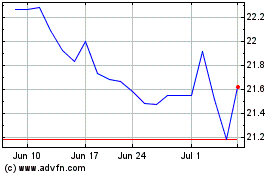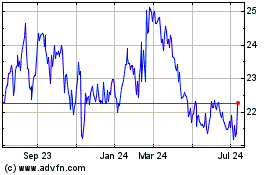New Hackett Research Quantifies Growing IT Services Gap; Demand to Increase by 17% through 2010 as Budgets Remain Flat
May 12 2009 - 9:30AM
Business Wire
IT budgets and staffing levels are expected to remain nearly
flat over the next two years, in large part due to the global
economic downturn. But demand for IT services will increase by more
than 17%, creating a significant gap that companies will need to
address with improved efficiency and productivity, according to a
new study published by The Hackett Group, Inc. (NASDAQ: HCKT).
Hackett�s research, which looks at results from more than 80
global companies, details best practices in three key areas that
companies can use to close this gap: IT cost control strategies,
demand management, and discretionary cuts.
Demand management is one particular area of potential efficiency
improvement the research cites as neglected by many companies. Only
about a third of all companies in the study use cost allocation or
charge backs to bill internal users based on the volume of IT
services consumed, or for IT work done on their behalf. In
addition, less than 30% have a service catalog in place that
defines a set of discrete service offerings with an associated
price per unit.
�Demand for IT services has always exceeded supply capacity,�
said Hackett IT Advisory Practice Leader David Ackerman. �But the
global economic downturn has put more pressure than ever before on
IT organizations to �do more with less.� The growing gap between
demand and budgets requires companies to broaden their mix of
techniques. IT organizations that stick to traditional
discretionary cuts are unlikely to truly solve the problem, and
also risk significantly damaging their ability to provide strategic
value to their company.�
According to Hackett Senior IT Research Director Erik Dorr,
�What we see here is that there�s significant untapped potential
for companies to cut costs and manage demand. While most companies
in our study have implemented basic IT cost control strategies,
other areas, such as demand management, have been largely ignored.
And even in traditional areas like discretionary cuts, which are
fairly inevitable in the current environment, there�s room for an
increased level of sophistication to reduce the stress on the IT
organization and to ensure that the cuts are sustainable.�
According to Hackett�s research, companies forecast that IT
budgets and staffing levels will each grow by only about 1.0 %
annually over the next two years, down from the annual growth rates
of 5.3% (for budgets) and 4.3% (for staff) seen over the past three
years. This 75% decline in budget growth contrasts sharply with
companies� projections for IT demand, which will shrink by only
15%, to 8.6% annually for the next two years, resulting in an
increase of more than 17% by the end of 2010.
Hackett�s research found that the drivers of IT demand are also
shifting, with organic business growth dropping significantly as a
priority while needs driven by process transformation and business
reorganization increase. Two other IT demand drivers, regulatory
compliance and M&A activity, are expected to remain fairly
stable.
Hackett�s research outlines best practices in three key areas
that companies can use to close the gap between flat budgets and
rising demand. The first, IT cost control, is a well-understood and
mature approach that has the greatest potential to reduce IT costs,
and includes key tactics such as: offshoring and outsourcing; IT
reorganization; technology rationalization; productivity and
process improvements; and supplier and contract management. In this
area, Hackett found that offshoring and outsourcing offer the
largest opportunity for cost control, more than three times the
savings of other IT cost control strategies, primarily because it
affects the largest share of the overall IT budget. But the study
also found that an across the board goal of 10% cost reductions in
this area is both realistic and achievable.
The study found that the second area, IT demand management, is a
highly underutilized technique by most companies. IT has
traditionally been more focused on how to meet ever-growing demand
than on implementing processes to curb that demand and ensure that
the highest value work gets done. As a result, demand management
techniques are less mature than other cost control techniques. The
study found that few companies use tactics such as charge backs,
service catalogs, or IT portfolio management to reduce costs,
despite the fact that these techniques can drive real savings.
This research also reinforces findings from a previous Hackett
study on IT Business Value Management that identified top
performing IT organization�s ability to directly link its
discretionary budget to the highest priority business objectives of
the enterprise � in and of itself, the most effective form of
demand management.
The final strategy -- discretionary cuts, which generally
involve mandated budget and staff reductions without underlying
process improvement or rationalization, is widely used by most
companies. But it is also the riskiest of the three approaches.
Unless process improvements are an integrated part of any
discretionary cuts, Hackett warns that they are likely to result in
degraded service levels and reduced overall effectiveness. It can
also be very challenging to sustain discretionary cuts on an
ongoing basis, the research found, as many companies quickly find
that they have very little fat left to trim.
About The Hackett Group
The Hackett Group, Inc. (NASDAQ: HCKT), a global strategic
advisory firm, is a leader in best practice advisory, benchmarking,
and transformation consulting services, including shared services,
offshoring and outsourcing advice. Utilizing best practices and
implementation insights from more than 4,000 benchmarking
engagements, executives use Hackett's empirically based approach to
quickly define and prioritize initiatives to enable world-class
performance. Through its REL brand, Hackett offers working capital
solutions focused on delivering significant cash flow improvements.
Through its Hackett Technology Solutions group, Hackett offers
business application consulting services that helps maximize
returns on IT investments. Hackett has worked with 2,700 major
corporations and government agencies, including 97% of the Dow
Jones Industrials, 73% of the Fortune 100, 73% of the DAX 30 and
45% of the FTSE 100.
Founded in 1991, The Hackett Group was acquired by Answerthink,
Inc. in 1997. Answerthink was renamed The Hackett Group, Inc. in
2008. The Hackett Group has global offices in the United States,
Europe and Asia/Pacific.
More information on The Hackett Group is available: by phone at
(770) 225-7300; by e-mail at info@thehackettgroup.com; or on the
Web at www.thehackettgroup.com.
Hackett (NASDAQ:HCKT)
Historical Stock Chart
From Jun 2024 to Jul 2024

Hackett (NASDAQ:HCKT)
Historical Stock Chart
From Jul 2023 to Jul 2024
